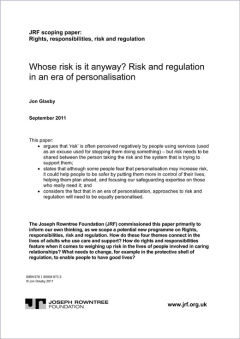Author: Jon Glasby
This paper provides a good overview of the debate around risk and personalisation. It draws on a wide-range of sources to help explain some of the complexities of this issue and to demonstrate that - if implemented sensibly - personalisation should increase safety for citizens.
In particular the paper:
- argues that ‘risk’ is often perceived negatively by people using services (used as an excuse used for stopping them doing something) – but risk needs to be shared between the person taking the risk and the system that is trying to support them;
- states that although some people fear that personalisation may increase risk, it could help people to be safer by putting them more in control of their lives, helping them plan ahead, and focusing our safeguarding expertise on those who really need it; and
- considers the fact that in an era of personalisation, approaches to risk and regulation will need to be equally personalised.

Six key principles are proposed:
- Risk is important – but people using services often perceive this in a disempowering way as something that is imposed on them by the system.
- We make people safe not by segregating them, but by building their confidence and by more fully connecting them to their communities.
- We reduce risks if we identify them in advance and plan what to do in an emergency.
- We might protect people better if we could focus our safeguards on those people who really need it.
- Personalisation and safeguarding are (or at least should be) two sides of the same coin.
- We set people up to fail if they don’t have enough support.
The issue of risk is one of the fault-lines for debate. It is to be hoped that government will not adopt an unthinking approach to risk and promote undue regulation and even greater bureaucracy. Shifting power to citizens and into communities is far more likely to promote the kind of safe and flourishing society that we should value.
The publisher is The Joseph Rowntree Foundation.
Whose risk it anyway? © Jon Glasby 2011.
All Rights Reserved. No part of this paper may be reproduced in any form without permission from the publisher except for the quotation of brief passages in reviews.
